Housing and Transportation Roundup #2
post by Zvi · 2022-12-27T13:10:00.979Z · LW · GW · 0 commentsContents
Building Houses Where People Want to Live Converting Offices People Don’t Want To Work At Into Houses Where People Want to Live How Much of This Housing Do We Need Exactly? What Is Rent Control? What is Affordable Housing? Free Mass Transit What If Density Doesn’t Increase Traffic Actual Progress Needless Frustrations Oh CEQA None No comments
Previously: #1
In my look back I concluded I want to be more focused and long-term oriented. Roundups by default are the opposite of that. This one was already in the pipeline (I have a rather large for-roundups draft to pull from), and on the margin easy to produce while creating a bank to pull from later. Still, I do note for myself the need to shift emphasis.
Building Houses Where People Want to Live
New York City Council Member here:
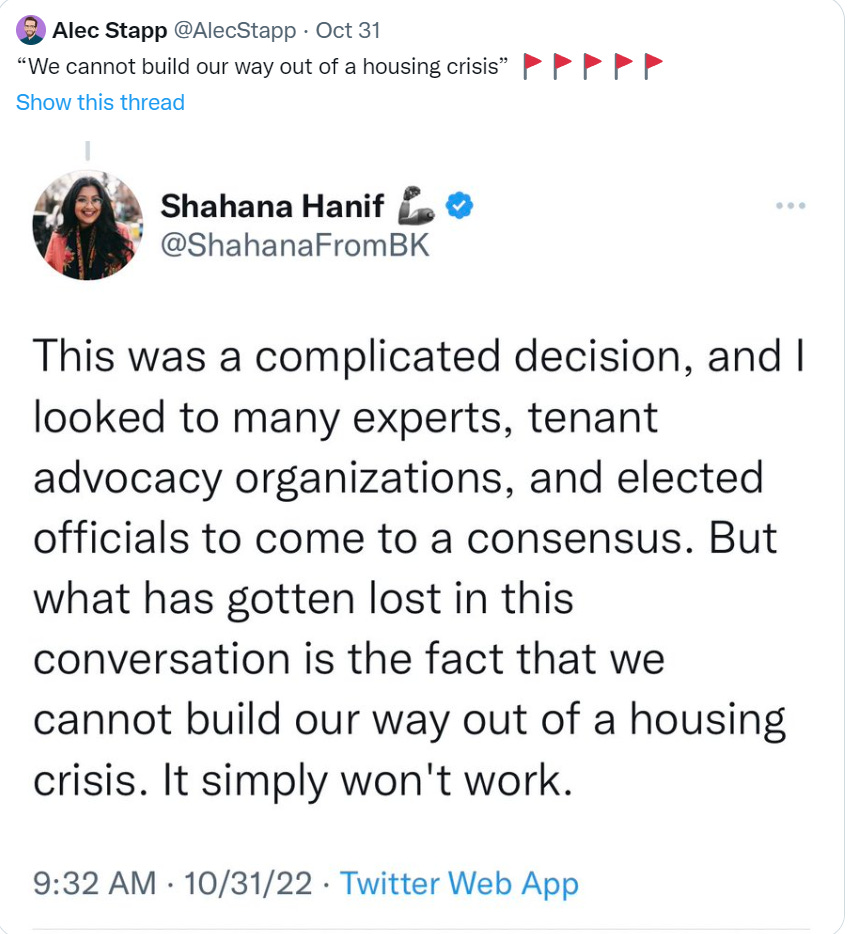
I mean no, not with that attitude.
Luckily, attitudes differ.
Stephen Hoskins thread on a study by Xiaodi Li, that found that building new luxury apartments in New York City did exactly what economics 101 says creating more housing should do, which is lower the cost of housing.

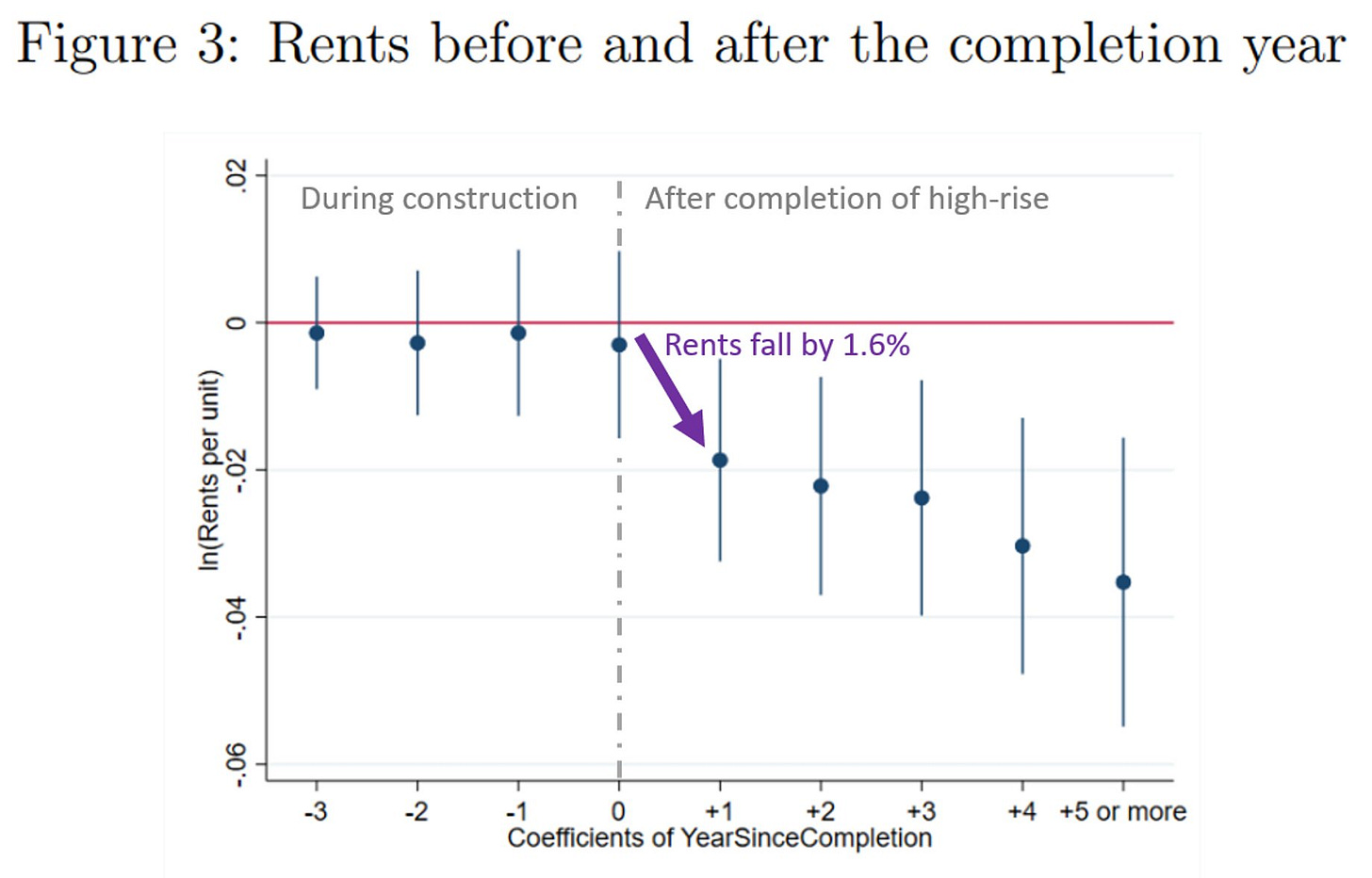
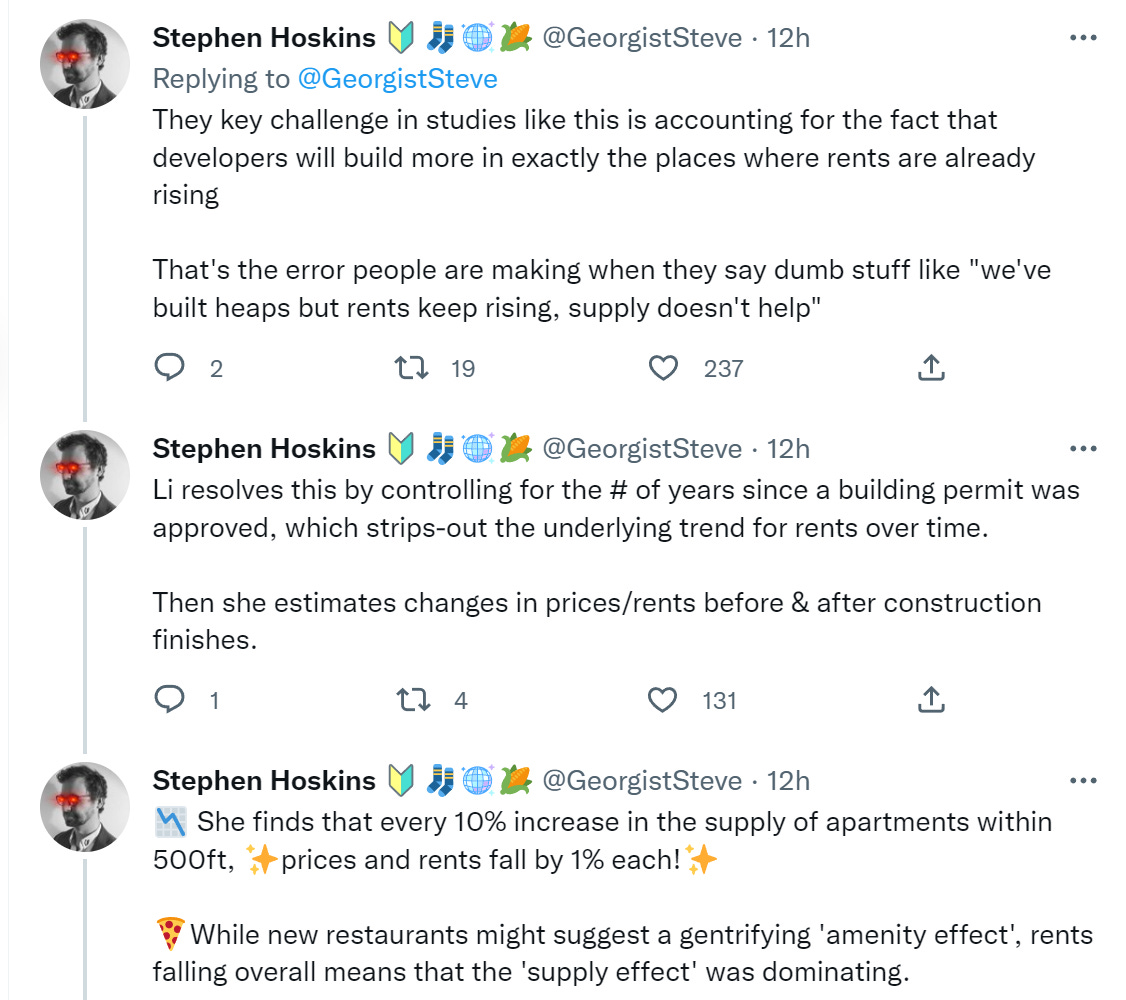
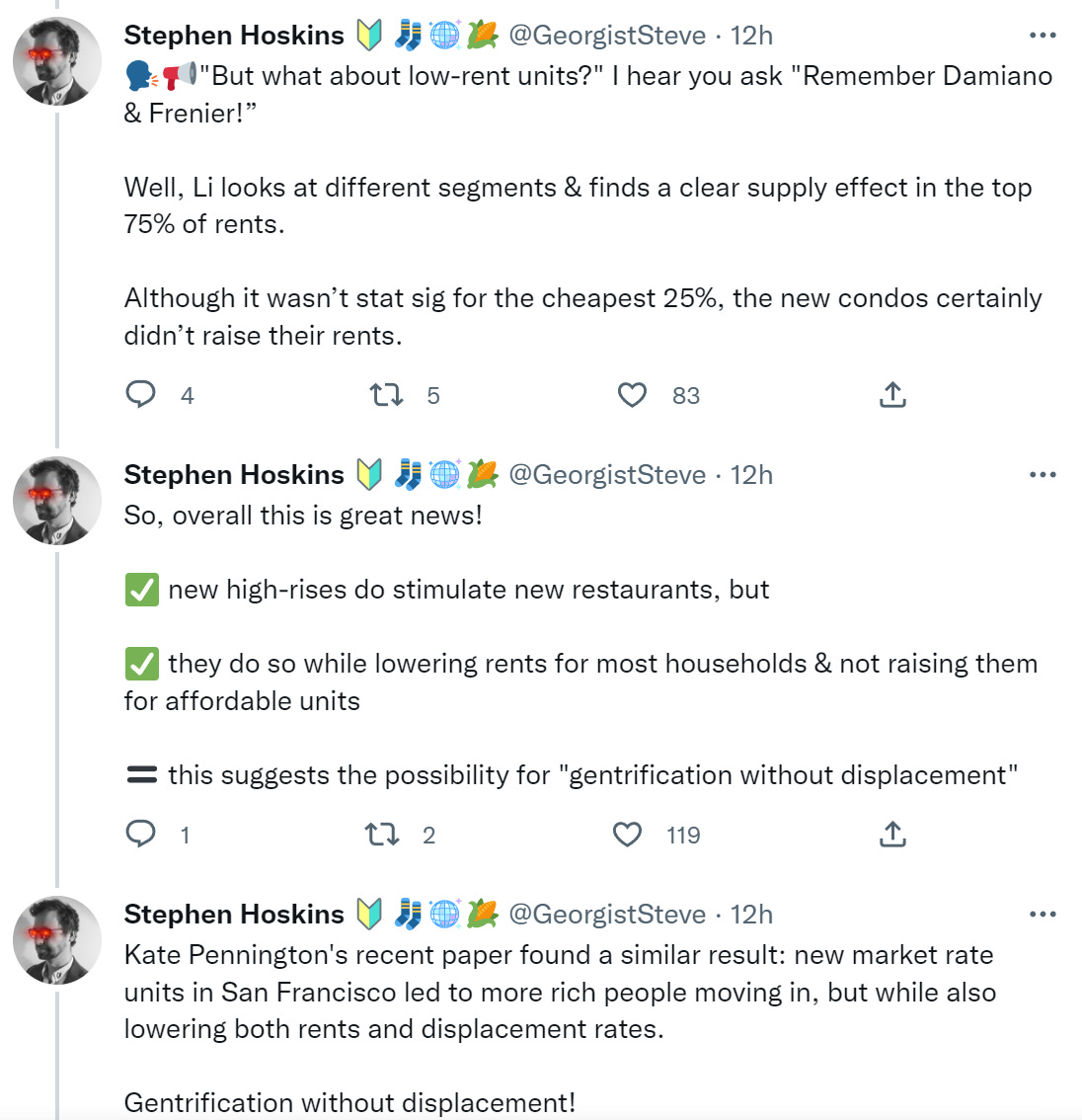
New restaurants is a strange measure. When more new restaurants open, sometimes it means that it became more worthwhile to open a restaurant relative to other uses of space. Other times, it means that an old business closed down, opening the way for a new restaurant. It is not obvious which effect dominates, so I would hesitate to draw conclusions from such data. In this case, it seems safe to presume that more housing means more residents means more restaurants.
Converting Offices People Don’t Want To Work At Into Houses Where People Want to Live
NYC developer Silverstein Properties seeks to raise $1.5 billion for converting older offices to residential buildings (Bloomberg). It is amazing news if this is commercially viable despite all the regulatory barriers. It would be obviously great if those barriers can be overcome at (in-context) reasonable costs.
DC offers tax incentives to convert old office buildings into residential housing, presumably to help overcome all the expensive regulatory burdens of doing so. A city realizing it actively wants something to happen might lead to subsidies. It is less likely to get pointless obstacles out of your way. The money does help.
This thread and the underlying report, an analysis of what New York needs to do to revitalize itself, also points out among many other things the importance of allowing reasonable conversion of office buildings into residential housing. For places like NYC there is no realistic substitute, and this could be bigger than all the other YIMBY initiatives combined in the medium term.
New York City Mayor Eric Adams goes full YIMBY, at least in theory, calls for 500k new units over the next decade. A good start. We shall see whether he can follow through, which has not been his strong suit so far.
How Much of This Housing Do We Need Exactly?
In the Atlantic, Annie Lowrey asks back in November how much housing construction it would take to make housing truly affordable again, fails to get a fully straight answer except ‘a lot.’
The closest thing to an answer she gets is the one from Enrico Moretti of UC Berkeley and Chang-Tai Hsieh of the University of Chicago.
In a blockbuster 2019 paper, they found that if New York, San Jose, and San Francisco—just those three cities—had the permitting standards of Atlanta or Chicago over the previous several decades, the U.S. economy would have been roughly $2 trillion bigger in 2009. American households would have earned an average of $3,685 more a year.
To come up with that estimate, the two economists built a complicated model that assumed Americans could move wherever their wages allowed and the housing supply would adjust as it would in a place with typical permitting standards. In such a world, they estimated in some associated work, 53 percent of Americans would not live where they are currently living. San Francisco would have an employed population 510 percent bigger than it does today—implying an overall population of something like 4 million, rather than 815,000, with 2 million housing units instead of 400,000. The Bay Area as a whole would be five times its current size, the economists estimated. The average city would lose 80 percent of its population. And New York would be a startling eight times bigger. Some back-of-the-envelope math (mine, not theirs) suggests that the United States would have—deep breath here—perhaps 75 million more housing units in its productive cities than it currently has.
The answers to ‘how much housing would people buy at the price it would take to build it in an adequate civilization’ and ‘how much housing we need to build to make housing affordable’ are remarkably close to the same question. So the question is whether this many people really would, if housing prices were magically reasonable, choose to move to New York or San Francisco.
This is where the question of immigration comes in. Who gets to bid on some of that housing? If the answer is ‘Americans but only Americans’ then I can see 4 million in San Francisco proper (assuming it also got its act together in other ways along the way, if not I shudder to consider it) but am deeply skeptical that 64 million (almost 20%!) of Americans would pick exactly Super New York City, especially given the density that is implied, even if you also fixed occupational licensing issues.
The flaw here, I think, is assuming Americans in general are so concerned with maximizing economic value produced. Some are, yet I am guessing quite a lot of them are not, or that they would satisfice. If New York is affordable in this scenario, and drawing this many new residents, many other areas become dirt cheap and are still completely fine, and things are going so well in general that people wouldn’t need to move to opportunity as ruthlessly.
Here’s another sign that the real answer is indeed Quite a Lot. When do you know the construction crisis is out of control? A good rule of thumb is ‘when it makes the (perceived or actual) sign value of other things start to flip.’ This has come to… Lansing, Michigan?
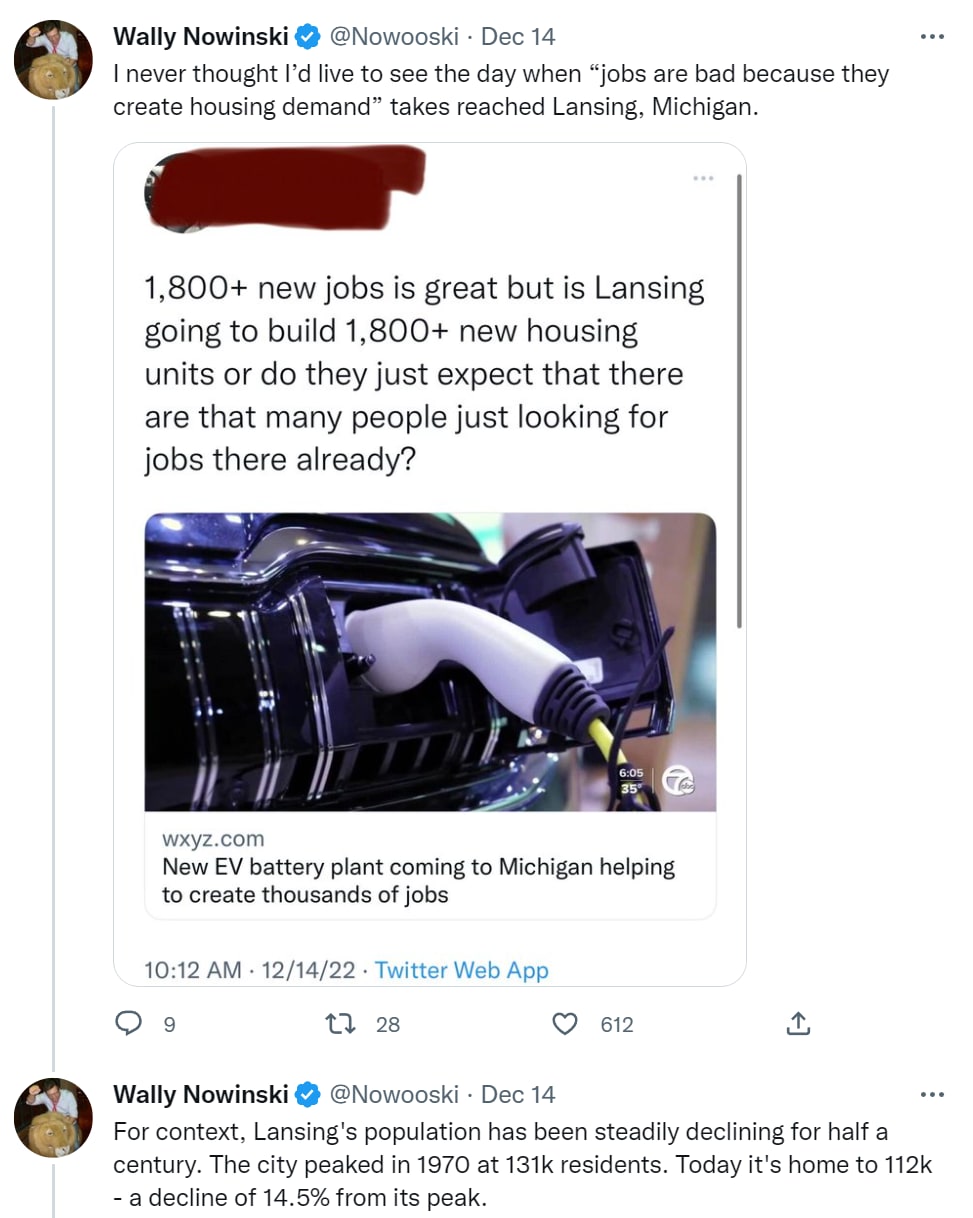

Given the natural rate of decay of housing stock, especially unused housing stock, combined with Americans continuously wanting more living space, it does seem reasonable that there might not be extra housing units lying around at the moment despite the population decline. So yes, compared to the counterfactual we now need to construct a few thousand new housing units.
An interesting research question is how many additional housing units are required here. The answer is not going to be a clean 1:1 because manufacturing jobs bringing in new workers creates other jobs (those people need all the usual goods and services) and reasons for others without jobs (like grandparents) to live somewhere.
I asked GPT for its take, and using a ‘superforecaster group gives its estimate’ trick got it to say 25%-40% of households will have someone work at the factory, so about a third. That seems reasonable. Prompt engineering, ho. Then I pinned down more numbers, and, well, whoops.

(It also wasn’t consistent. When I said 2,000 jobs were available, it said 80%).
What Is Rent Control?
Small town in Marin County passes rent control and anti-eviction provisions, Democratic Socialists behind the effort. Matt Yglesias speculates they may have found a new way to ban housing construction.
I think that’s wrong. This isn’t New York City or San Francisco here, and also rent control cannot be applied to units built after 1995. So while it can level a city’s existing housing stock over time due to lack of maintenance, rent control can’t prevent new construction, although eviction protections can do some lifting.
What they have done is find a way to ban renting.
If rent control exists, while sale prices are uncontrolled, the logical response to ‘I do not want to live in this apartment I own’ is to sell it to someone else who does want to live there. Thus, people who can afford to and want to buy displace those who want to rent, keeping the poor and undesirable crowd out of the city. A law restricting supply having the exact opposite effect and motivation to its claimed effect and motivation, and turning out to benefit insiders and rich people instead of outsiders and poor people? How unexpected and surprising.
A lot of rent controlled apartments get rented anyway. This seems like a transparently awful deal for the landlord, although usually less awful than leaving the apartment permanently vacant. Presumably this is because it is also illegal to sell the apartment, also known as ‘converting into a condo.’ The combination of ‘you can’t sell’ with ‘you can’t rent’ seems a lot like ‘you don’t actually own it in any meaningful sense.’
What is Affordable Housing?
A solution to housing being unaffordable that will not work as well is to tax new housing by saying ‘I dub a lot of the new housing affordable,’ meaning made intentionally bad and then misallocated at a below-cost price. That appears to be the route Mayor Wu is going to try in Boston.

Adjectives like ‘affordable’ in practice, of course, mean ‘must follow our rules in order to allocate resources to favored groups via power.’ The default thing this does is stop a lot of resources from being allocated, making the thing less affordable.
Mandatory housing affordability was meant to be a “grand bargain” with bigger developers by offering them upzoning, Sen said. But it did not distinguish between those investors and regular homeowners who may want to build on their own properties, even though other cities have ensured their affordable housing requirements don’t apply to smaller developments.
“It is actually, in fact, making it more expensive for people to live here,” Adams told MarketWatch. “It’s driving up rents.”
As a result, the title character wants to build four units on her property to offer to her family, and the city wants to charge $77,000 in such fees before she can do that. Thus, no new units. You see, ‘affordable housing’ means giving strangers below-market rent, family does not count, and to even have the city consider this would require $50k+ in architect fees alone with no confidence it would be accepted. Essentially anything outside of standardized big projects that work the system is under heavy tax. Ordinary life that doesn’t pass through such systems is made illegal.
In 2021, the city also funded low-income housing projects with nearly $57 million in mandatory housing affordability payment proceeds to support 990 affordable rental apartments and 17 condominiums for low-income, first-time homebuyers.
One should always do the math on these things. That’s $57 million for 1,007 rental units, or $56k/unit. Not bad. An order of magnitude (or more) smaller than similar numbers from California.
Free Mass Transit
Matt Yglesias comes out for enforcing the collection of fares on mass transit. This is split into two arguments.
- If you have a rule that rides cost money, you should enforce that rule.
- You should have a rule that rides cost money.
I am totally here for the first point. If you don’t want to enforce such a rule, then you should stop charging money in exchange for rides.
I extend this logic to most other laws in other contexts. Either enforce the rule or change it. If a rule only functions when selectively enforced, that is a bad rule. If you think a rule is bad, repeal it. Don’t leave it there without enforcement.
Matt also says that a nice side benefit of rule enforcement is getting an excuse to search rule breakers. That seems plausible.
The second argument is that it is good to charge money for riding mass transit, also made by this Atlantic article. This has always struck me as some combination of bonkers and a bug in the political dynamic systems.
Of course a standard free transit proposal doesn’t say that — it says we should spend more money to make the fares free. But why not spend the money to improve service?
That is not what spending money means. Charging fares raises money. You are charging riders of mass transit rather than using other taxes, despite wanting to see more people ride mass transit, and despite this being regressive and not so cheap to enforce. That only impacts how much you spend on the transit if you choose to let it.
The core argument here is that as a public choice problem we are fine with using rider fees to pay for the cost of good transit, but are unwilling to use other local taxes in similar quantities to fund similarly high quality free transit. It is seen as ‘expensive’ in a way it would otherwise not be seen as expensive.
I buy that this seems mostly true in practice. It seems important to be explicit about it.
I also want to be explicit that this seems bonkers. The costs of fare collection and enforcement greatly exceed the costs of collecting general taxes. The friction reduces ridership substantially and takes up mind share. Such taxes are highly regressive, paid by those who can least afford it. The value to a city of a marginal ride is by default in excess of its costs, as it facilitates work and commerce and avoids traffic.
The good argument I can think of against free fares is that we want to prevent usage and therefore need to ration via price. This could in some corner cases be true if there is limited supply with an inability to reasonably add more, such as the green (456) subway line on the east side of Manhattan. Seems mostly like the exception that proves the rule. The other reason is to exclude those unwilling to pay, such as the homeless, which does not seem to be working out great.
If your goal is instead to attract more riders, you want to lower the price. To free.
If you ask someone who actually rides the bus, it’s to get them to where they need to go. To meet any of these goals, transit agencies need to attract more customers. The best way to do that is to run more buses and ensure that they arrive and depart in a timely fashion.
Bus riders are consistent on this point. One 2019 study of transit riders asked respondents to name the most important areas for improvement and found that the quality of the transit service came first. To increase satisfaction and, consequently, transit use, riders wanted more frequent, safe, and reliable service. Significantly lower on the list of priorities? Concerns about fares.
This is a standard argument of the form:
- X matters more than Y.
- Therefore, Y does not matter. Ignore it.
Riders are mostly not concerned about fares. That is very different from being price insensitive. Make rides free on the margin, and you’ll see substantially more rides. I can attest to this behavior on a personal level. Everyone I know including myself takes more rides once they have an unlimited MetroCard for the month and none of us are ‘concerned about fares.’ Also a lot of this is the time and trouble and stress of dealing with payment, taking this away is a big game as well. And even if it was still far down on the list of things that matter, that doesn’t mean it isn’t worth getting it right.
The piece then goes on to talk about how yes of course ridership goes up a lot, but only the riders that would have otherwise walked, so increased ridership is bad, actually.
The good news is that this is happening in some important places. DC makes its buses free, joining places like Kansas City, Tucson and a little place called Albuquerque.
In D.C., free bus service is expected to cost $43 million in 2024 and increase slightly each year thereafter.
That is chump change. About $50 per resident. Seems obviously insanely great.
What If Density Doesn’t Increase Traffic
It is traditionally assumed that density increases traffic. What if that isn’t true?
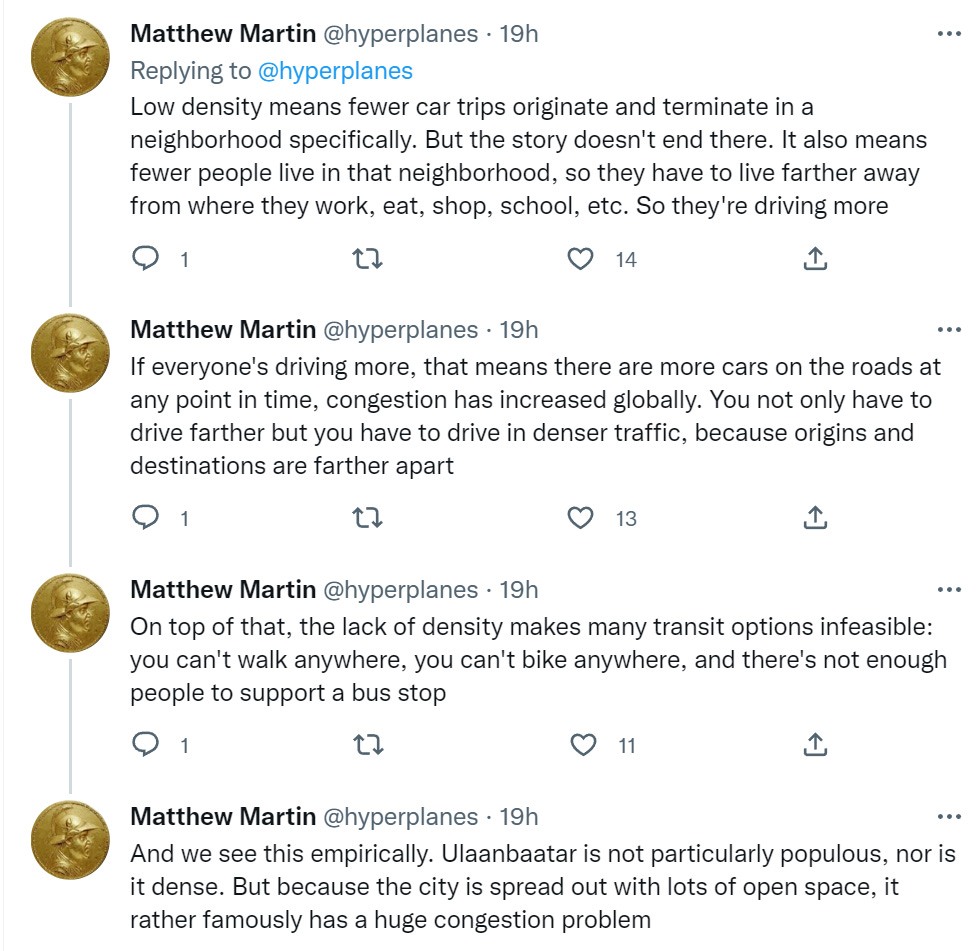
It is obviously true at the extremes. In the middle of desert, there are no people and there is no traffic. If we Built the Cube without any new roads or trains or airports then that would be one hell of a traffic problem.
However, in the middle of that, on the margin, the answers are not so obvious, nor can different sources agree on which cities even have the worst traffic. I don’t spend too much time in traffic here in New York City because it is so dense I don’t drive at all, and almost never even take a taxi. Cities like Atlanta and Los Angeles have terrible traffic that seems to be due to lack of density. Even if traffic ‘gets worse’ with more density, shorter trips in space can make up for it.
This seems like a study that needs to be done. It is non-obvious what the correct design would be, yet it seems like exactly the kind of thing Balsa should be commissioning once things are set up – what is the relationship between density, zoning, miles travelled, traffic and time spent in cars? Does more dense construction mean more time spent on the road, or less time, and how do you plan so it will be less rather than more?
Actual Progress
New York City Mayor Eric Adams goes full YIMBY at least in principle, and calls for 500k new housing units over the next decade. We will see what he does to put that into action.
Several cities end all parking requirements.
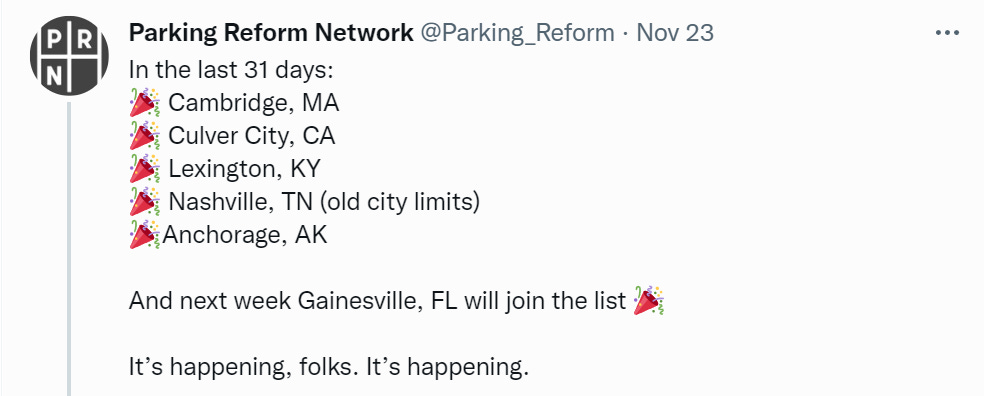
Needless Frustrations
The great sidewalk shed debate, or rather the middling ‘why do we have all these useless sidewalk sheds?’ inquiry.


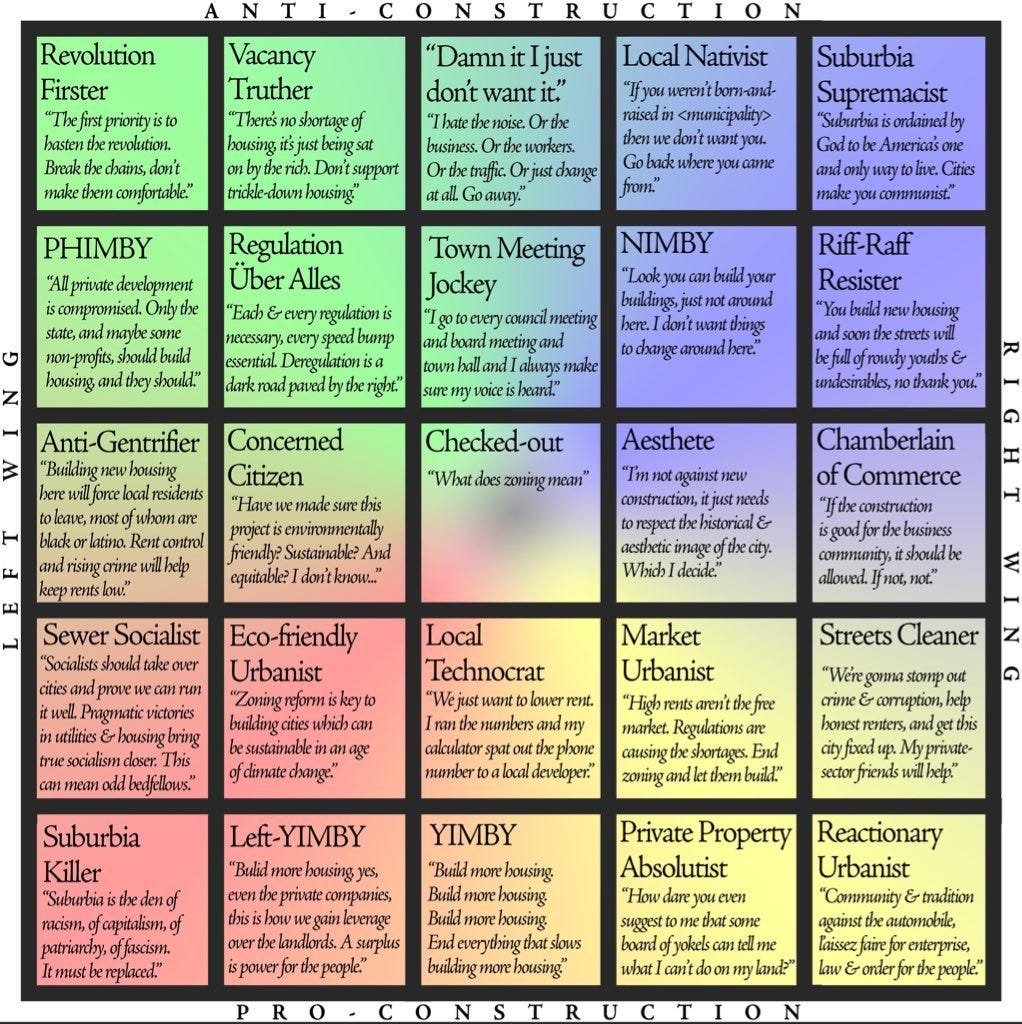
Here’s a fun case of kindergarten thinking.



Oh CEQA
It looks like CEQA (California’s NEPA) could soon be expanded by the courts to give carte blanche to anyone who wants to block anything anywhere, even more than before? Note this is a tentative ruling. It’s still worth walking through the logic here.


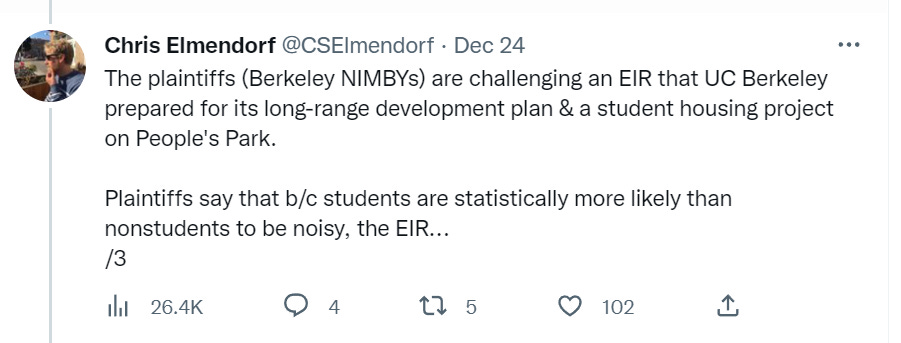


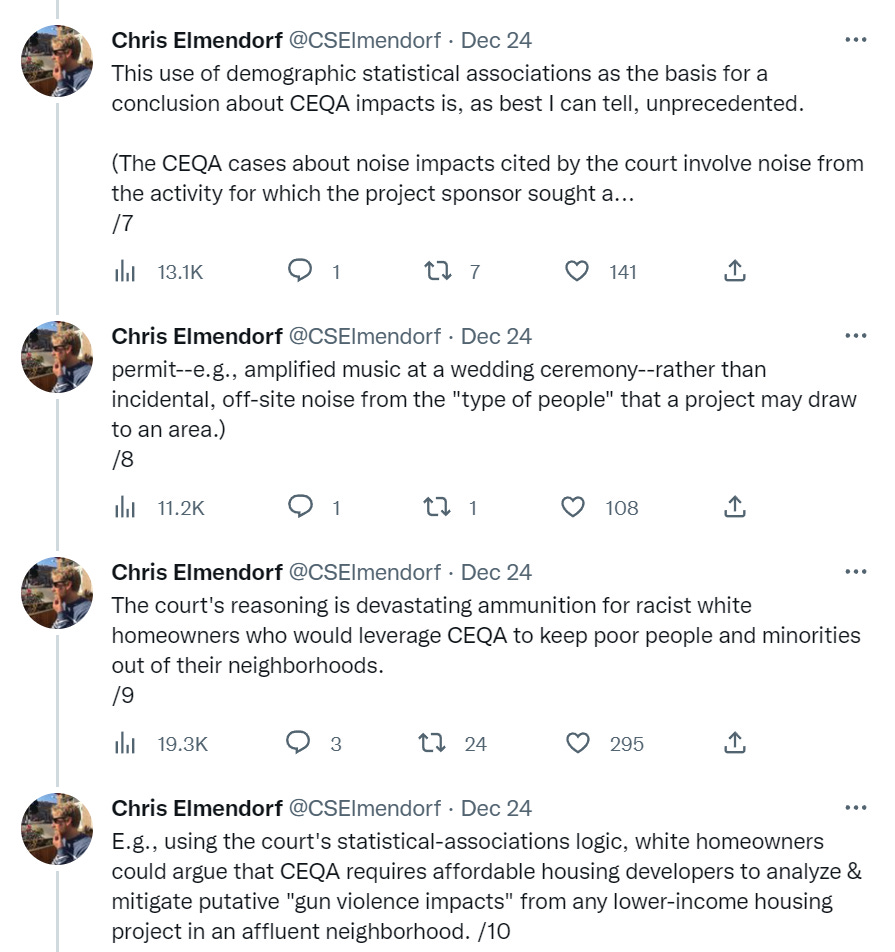
Chris here is treating CEQA as if it is a law in the traditional sense, where it is composed of words that have meaning and logic that is to be internally consistent, despite the court here making a ruling that respects none of these things.
If you actually believe the logic here, Chris seems right.
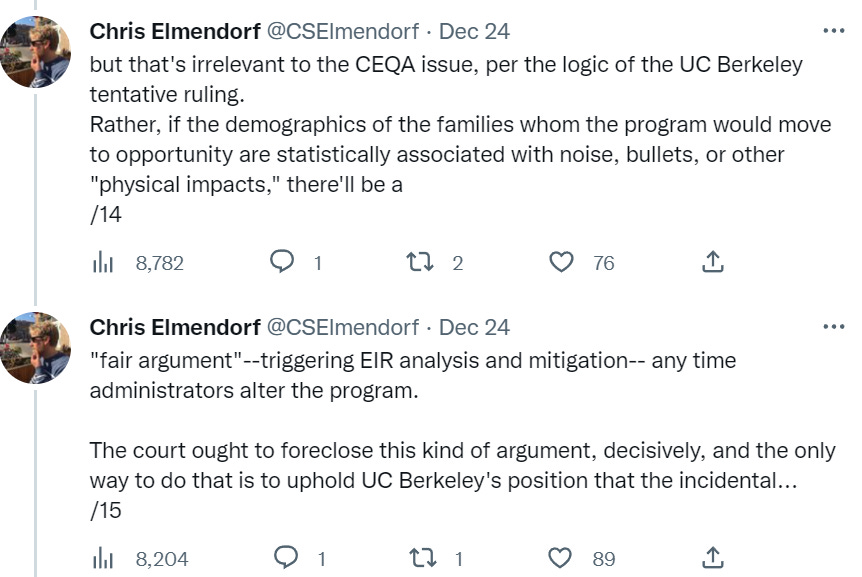
CEQA and NEPA are creatures of Asymmetric Justice. You are distinctly responsible and blameworthy for every change you introduce. If any of the changes negatively impact anyone, it is on you to properly address this or the whole project is dead, no matter how valuable its benefits.
The new principle here – again, if you believe words have meaning, or you think the courts will otherwise go for the logical implications – puts that on steroids by including as a valid target any statistical association of new residents with any undesired outcome.
As Chris points out, that means that any group of potential new residents that is statistically likely to be more noisy, or disruptive, or violent, or anything else homeowners might find undesirable is moving in, you need a mitigation plan for that. So where exactly are the courts going to say ‘wait, no, not that, that’s racist or classist or excludes all affordable housing on principle?’
Or will they bite the bullet and say that the existence of poor people or young people (or the wrong other subgroup of people) is something existing homeowners do not want in their environment, and therefore illegal to amplify under CEQA? That housing is illegal to build because if you build housing people might live in it?
It gets better. There’s also the argument that making it so people want to live somewhere is bad, because people who want to live there might not be able to and therefore become homeless. Better have your mitigation plan ready.



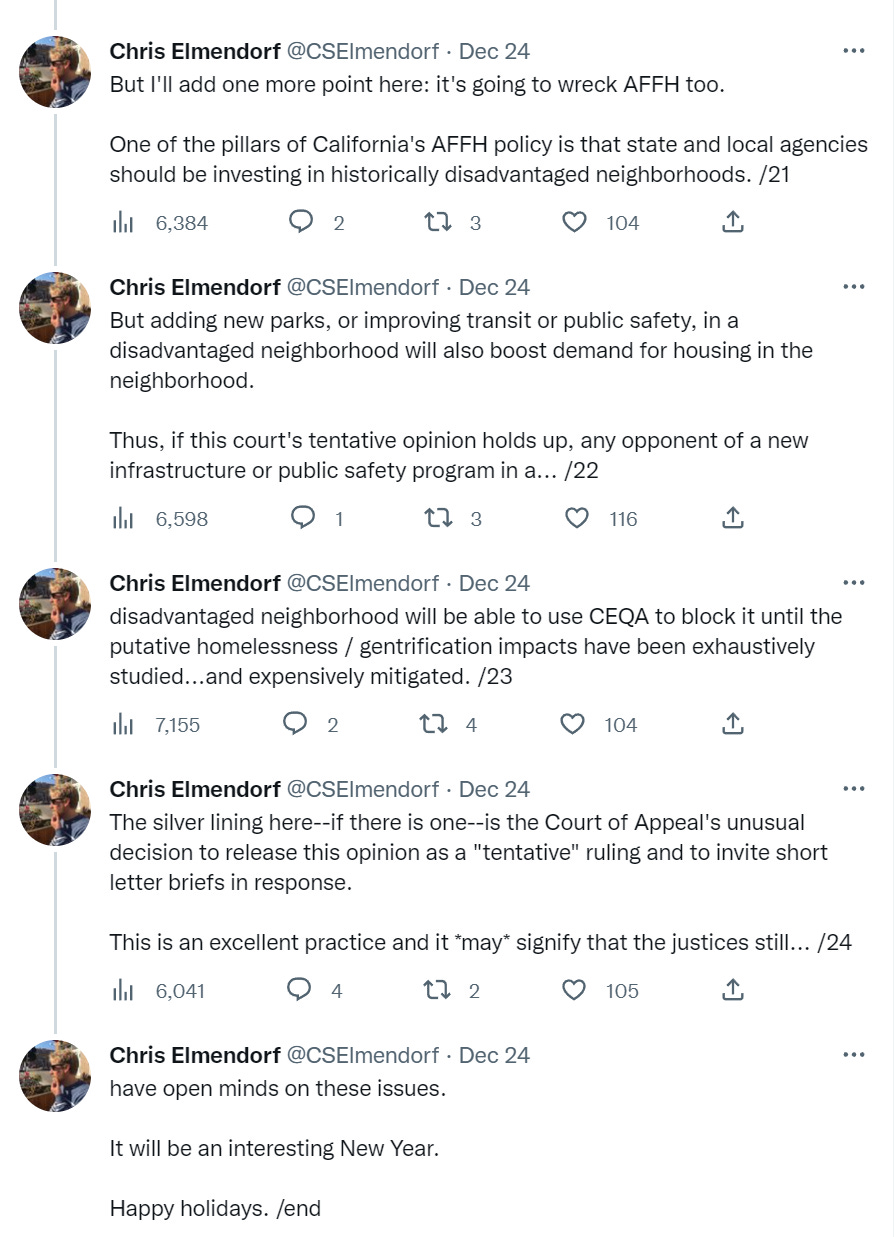
Again, as a matter of logic and the meanings of words, logic here checks out. This is a fully general argument against ever doing anything that changes anything, ever.
- If your change does not make anything better or worse, nothing changed.
- If your change makes something worse for someone, that’s your fault.
- If your change makes something better for someone, that’s also your fault, because it will make people want to be there and they might become homeless.
- Thus, any change you make violates CEQA. QED.
The good news is that this is not how I understand such judges to apply such laws, and this will not be consistently applied when it has different implications that the judges don’t want to block something, or not for a particular reason. The other good news is that the laws could be changed at any time. The bad news is that judges seem to often want to block such things, and that changing these laws seems in practice to be near impossible even after it is made clear how much they have been perverted.
Another way of thinking about this is that the court has decided it does not want to allow California to admit more students into its universities, and instead wants to favor rich landowners in the area, and is making new law in order to enforce that against the will of the people.
This summary is even starker, also offered as a ‘no, really, they actually said that.’

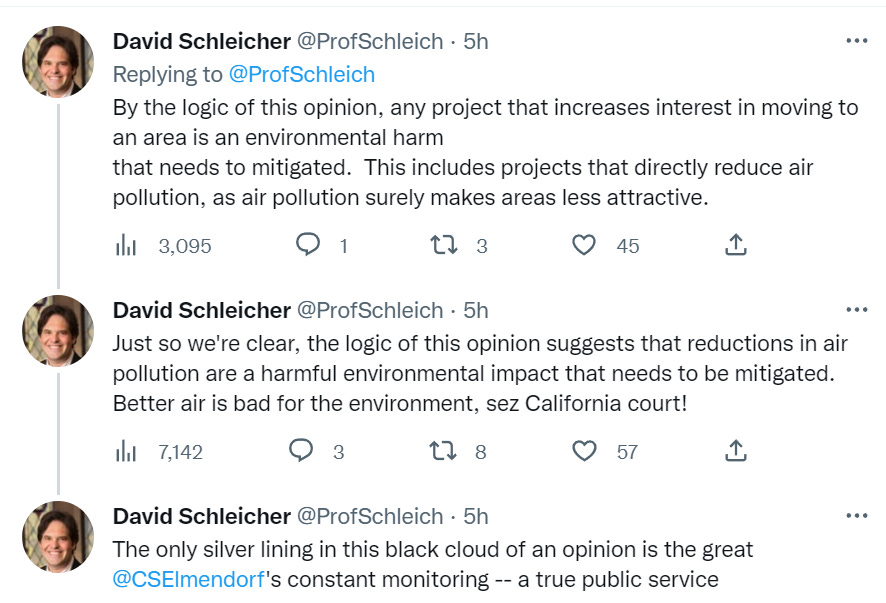
California court has declared that anything good requires mitigation.
What else might such courts disfavor?
0 comments
Comments sorted by top scores.